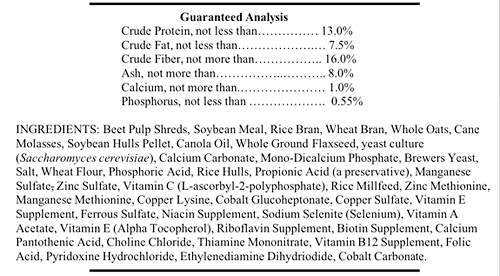Understanding
horse feed labels
About
Our Feed
Equine
Products
Dr. Bray's
Corner
Equine
Nutrition FAQ
Where
to Buy
How to Read a Label for Horse Feed
Labeling can serve as a useful and important tool for horse owners to make intelligent decisions regarding feed selection. Understanding horse feed labels and the information printed there will assist the horse owner in:
- Selecting and evaluating commercial feed mixes
- Differentiating between feeds or mixes that primarily provide a source of energy, protein or fiber
- Selecting feeds that economically provide the best value
- Differentiating nutritional facts from marketing propaganda and testimonials
- With some skill, even estimating the digestible energy content of a feed mix based on fiber and fat content.
Labels generally provide a Guaranteed Analysis and a list of ingredients. A basic feed label will generally appear as the example below.
Guaranteed Analysis
The guaranteed analysis found on the horse feed label provides a percentage estimate of the nutrients or diet components that are contained in the feed. They are expressed as minimums (aka not less than) and maximums (aka not more). All labels must provide protein, fat, fiber, and ash content expressed as a percent. Crude protein, crude fat and crude fiber terms are self-explanatory regarding the components they respectively represent. Crude protein and crude fat are nutrients and crude fiberis a dietary component.The wordcrude means “a rough estimate” because the laboratory analysis for protein, fat and fiber involve indirect laboratory measurements. Ash represents the total minerals and is not a useful value in determining the type and amounts of minerals. Other specific nutrients may be listed, in this example the macro minerals calcium (Ca) and phosphorus (P) are provided.
Feed Ingredients
Ingredients are a crucial part of understanding horse feed labels. Usually ingredients are listed in order of magnitude, the largest percentage by weight to the smallest. Most companies follow this pattern however, there are some states that do not require this type of listing. Some companies still only provide the collective feed names compared to specific feedstuffs. An example would be identifying plant protein products in the ingredient listing compared to identifying the primary protein feedstuffs such as soybean meal, flaxseed meal, or cottonseed meal. This practice is used to minimize preparation of new labels for formulations that are changed. Formula changes are usually based on the least-cost concepts in ration formulation. Collective feed names also provide companies flexibility if they decide to add, discontinue, or replace the use of one or more feed ingredients in the feed mix.

